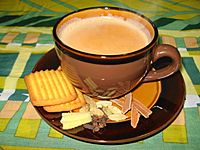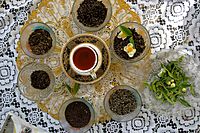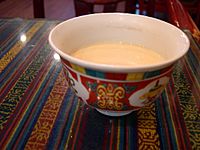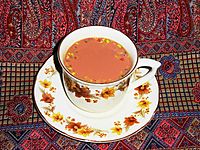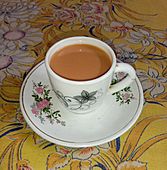Indian tea culture facts for kids
India is a huge country and the second largest producer of tea in the world, right after China. It's also the biggest tea drinker globally, using almost 30% of all the tea made! Tea is so important that it's the official 'State Drink' of Assam, a region famous for its tea. There were even plans to make it the official "National Drink" of India.
Tea has been used in India for thousands of years, not just for drinking but also for its health benefits. Ancient Indian medicine, called Ayurveda, uses many plants and spices like holy basil (Tulsi), cardamom (Elaichi), and ginger. These are often added to tea, making it tasty and good for you. The sweet, milky taste of chai (Indian tea) helps to make some of the stronger spices more enjoyable.
For a long time, the history of tea in India was a bit of a mystery. Records show up again around the first century CE, with stories about Buddhist monks and tea. We know that tea plants grew naturally in eastern and northern India and people there have been drinking it for a very long time. However, large-scale tea farming in India only began when the British East India Company arrived. They turned huge areas of land into tea plantations.
Today, India is still one of the world's top tea producers. Most of the tea grown in India is also enjoyed by people within India. The Indian tea industry is very modern and owns many famous tea brands around the world. The Tea Board of India manages everything about tea production and trade in the country.
Contents
Tea's Long History in India
The exact start of tea farming in India isn't fully clear. We know that tea plants grew wild in India, and local people brewed them. However, there aren't many old written records about tea drinking in India before the British arrived.
Some tribes, like the Singpho and Khamti people, who lived where the Camellia sinensis plant grew naturally, have been drinking tea since the 12th century. It's possible tea was used under different names too. Some historians even suggest that an ancient Indian drink called "Soma" might have been tea. While tea plants are native to both East Asia and India, many of the oldest stories about tea come from China.
Early European Discoveries of Indian Tea
The next time tea in India was mentioned in records after the 12th century was in 1598. A Dutch traveler named Jan Huyghen van Linschoten wrote in a book that people in Assam used the leaves of the tea plant. They ate them as a vegetable with garlic and oil, and also drank them. In the same year, another group of Dutch explorers also wrote about tea in India.
British Surveys and Tea Farming
In 1877, a writer named Samuel Baildon shared an interesting story. He wrote that some merchants in Calcutta were talking about growing Chinese tea seeds in Assam. A local man from Assam heard them and said, "We have the plant growing wild in our jungles."
It was then confirmed that an Assamese nobleman, Maniram Dutta Barua, showed British surveyors existing tea farms and wild tea plants in the Assamese jungle. This discovery was very important for the future of tea in India.
The East India Company and Tea Production
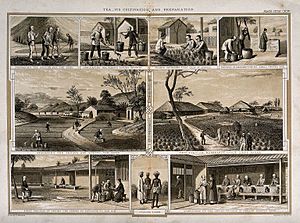
In the early 1820s, the British East India Company started growing tea on a large scale in Assam, India. They used a type of tea plant that the Singpho tribe traditionally brewed. In 1826, the British East India Company took control of the region.
The first English tea garden was set up in 1837 in Upper Assam. By 1840, the Assam Tea Company began making tea for sale. They used local workers who were often forced into labor. From the 1850s onwards, the tea industry grew very quickly, taking over vast areas of land for plantations. By the early 1900s, Assam became the world's leading tea-producing region.
Even though native Indian tea plants were discovered, the tea industry in India first started with seeds brought from China. About 80,000 Chinese tea seeds were planted in different parts of India. Only later did farmers start using the native Indian tea plants. Today, the Chinese type of tea plant is used to make Darjeeling tea. The native Assamese plant produces the rest of India's tea.
India was the world's top tea producer for almost a century. However, recently China has produced more tea because it has more land available for farming. Even so, Indian tea companies have bought many famous foreign tea brands, including British ones like Tetley and Typhoo.
How Tea is Made in India Today
India is the world's largest tea-drinking country. However, each person in India drinks a modest amount of tea per year, about 750 grams. This is because India has a very large population and many people are not wealthy.
The way tea is harvested in India depends on the type of tea and the land. Fine-leaf tea is picked by hand. Hand shears are used on mountain slopes and in places where large machines cannot go. A skilled worker can pick 60 to 100 kilograms of tea per day by hand. Machines can cut between 1,000 and 2,000 kilograms, but these are usually used for lower-quality teas often found in teabags. Any leftover tea "fluff" or waste from processing is used to make caffeine for soft drinks and medicines.
Different Types of Indian Tea
The Tea Board of India lists several types of tea found in India. These include Darjeeling, Assam, Nilgiri, Kangra, Munnar, Dooars-Terai, Masala Tea, and Sikkim tea. Most of these teas are named after the regions where they are grown. They are also legally protected as "Geographical Indicators," meaning only tea from that region can use the name.
What is Darjeeling Tea?
Darjeeling tea is grown high up in the mountains, between 600 and 2000 meters above sea level. These areas get a lot of rain, over 300 centimeters on average. Darjeeling tea plants were first planted in the 1800s. Now, Darjeeling tea has its own special brand known worldwide.
To make sure you are getting real Darjeeling tea, the Tea Board of India says you should look for the Darjeeling logo. You should also check for the Tea Board's certification and license numbers. The Tea Board suggests that Darjeeling tea tastes best when served in porcelain cups, without any sugar or milk.
How People Drink Tea in India
-
Masala chai, a popular tea in Northern India, often served with tea biscuits.
-
A cup of Darjeeling tea.
-
Butter tea or gur gur, popular in Himalayan regions like Ladakh and Sikkim.
-
Noon chai, a popular tea in the Kashmir Valley.
-
A cup of milk tea in Kolkata.
In India, people drink 15 times more tea than coffee. Tea is made both at home and bought from outside. You can easily find tea at the many tea stalls on almost every street in India. These tea stalls are a big part of Indian culture. There are even modern tea-themed cafes in big cities now.
The word "Chai Wallah" is Hindi for the person who runs a tea stall. Even famous people, like India's Prime Minister Narendra Modi, worked at a tea stall when they were young. The phrase "Chai-Pani," meaning "tea and water," is a common way to welcome guests in Indian homes.
Historians say that the love for tea in India grew because tea producers worked hard to make it popular. At first, companies like Brooke Bond gave out free tea samples from horse-drawn carts. They also introduced the British way of drinking tea with a little milk and sugar.
However, Indian tea is usually made differently from British tea. In India, tea leaves are often boiled directly with milk and sugar. Sometimes, the tea leaves are used just for flavor. In many parts of the country, the most special tea is made by boiling the tea leaves only in milk.
There are many different ways to make tea in India, depending on the region and culture. Most tea drinkers in India prefer milk tea. In Southern India, Masala Chai is not as popular. Instead, people drink tea brewed with milk and sugar. In Assam, popular teas include Sah, Ronga Sah (red tea without milk), and Gakhir Sah (milk tea). In North India, popular teas are Masala Chai, Kadak Chai (a very strong tea), and Malai Mar Ke Chai (tea with a lot of cream).
Images for kids
-
A Chaiwala at a stall in Varanasi.
See also
 In Spanish: Cultura del té en India para niños
In Spanish: Cultura del té en India para niños


